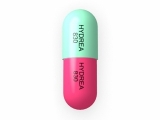Importance of micromeritics in pharmacy terms glossary
In the field of pharmacy, a comprehensive understanding of micromeritics is of utmost importance. Micromeritics is a branch of science that deals with the study of small particles and their properties. It involves the analysis and characterization of particles in terms of their size, shape, surface area, and porosity. As pharmacy deals with the formulation and manufacturing of drugs, a thorough knowledge of micromeritics allows pharmacists to optimize drug delivery systems and ensure the stability and efficacy of pharmaceutical products.
One of the key reasons why micromeritics is significant in the pharmacy field is its impact on drug dissolution and absorption. The size and surface area of drug particles greatly affect their solubility and bioavailability. Micromeritics helps pharmacists understand how particle size distribution can influence drug release and absorption rates, enabling them to design formulations that enhance drug effectiveness and patient outcomes.
Micromeritics also plays a crucial role in the development and production of various dosage forms. By studying the size and flow properties of powders, pharmacists can optimize the manufacturing processes and ensure uniformity in tablet compression, capsule filling, and granulation. Furthermore, micromeritics assists in the formulation of suspensions and emulsions by determining the ideal particle size for achieving stability and uniformity in these dosage forms.
Additionally, micromeritics contributes to the development of drug delivery systems and drug targeting strategies. By analyzing the particle size and surface characteristics of carriers and nanoparticles, pharmacists can design drug delivery systems that improve drug solubility, enhance drug stability during storage, and facilitate drug release at the desired site of action. Micromeritics also aids in the production of nanoparticles with controlled release properties, allowing for the targeted delivery of drugs to specific tissues or cells.
In conclusion, micromeritics plays a vital role in the pharmacy field, serving as a foundational knowledge base for the optimization of drug delivery systems, formulation of pharmaceutical products, and development of drug targeting strategies. Its understanding allows pharmacists to enhance drug efficacy, stability, and patient outcomes, making it an essential component of the pharmacy terms glossary.
The Role of Micromeritics in Pharmacy
Micromeritics plays a crucial role in the field of pharmacy, specifically in the development and manufacturing of pharmaceutical products. It involves the study and characterization of particles and their behavior, providing valuable insights into the formulation and performance of drugs.
Particle size analysis is an important aspect of micromeritics. It helps in determining the size distribution of particles, which is vital for various pharmaceutical processes such as drug dissolution, absorption, and stability. Understanding particle size allows pharmacists to optimize drug formulations and ensure uniformity in dosage forms.
Surface area measurement is another key component of micromeritics. The surface area of a drug particle directly affects its reactivity and dissolution rate. By quantifying surface area, pharmacists can predict drug release and absorption rates, as well as optimize the manufacturing processes to enhance drug performance.
Furthermore, porosity analysis is essential in micromeritics. Porosity refers to the void spaces within a particle or material. It affects drug storage, release, and stability. Through porosity analysis, pharmacists can determine the ideal porosity level to achieve desired drug release profiles and ensure efficient drug delivery.
Micromeritics also plays a significant role in the development of drug delivery systems such as nanostructures and microparticles. By understanding the particle properties and behavior, pharmacists can design and optimize drug carriers for targeted drug delivery, controlled release, and improved bioavailability.
In conclusion, micromeritics is indispensable in pharmacy as it provides valuable insights into particle characteristics, helping pharmacists optimize drug formulations, predict drug performance, and develop innovative drug delivery systems. It contributes to the advancement of pharmaceutical science and plays a vital role in improving patient outcomes.
Importance of Particle Size Analysis
Particle size analysis is a crucial tool in various fields, including pharmaceutical research and development. It provides valuable information about the physical properties of particles, which can have a significant impact on their behavior and performance. This analysis helps researchers and scientists understand the characteristics of particles and optimize their formulations for better efficacy and safety.
Improved drug delivery: The size of particles can greatly affect their ability to be absorbed by the body. Smaller particles have a larger surface area, which enhances their dissolution rate and improves drug bioavailability. Particle size analysis allows pharmaceutical scientists to tailor drug formulations and optimize particle size to achieve the desired therapeutic effects.
Uniformity and stability: Particle size distribution plays a crucial role in the stability and uniformity of pharmaceutical products. Inconsistent particle sizes can lead to uneven dispersion, poor dissolution, and formulation instability. By analyzing particle size, scientists can ensure uniformity and stability, improving the quality and performance of pharmaceutical formulations.
Quality control: Particle size analysis is an essential part of quality control in pharmaceutical manufacturing. It helps ensure that products meet the required specifications and comply with industry standards. By monitoring particle size, pharmaceutical companies can identify any deviations or abnormalities that may affect the product's efficacy and safety.
Enhanced product development: By understanding the particle size characteristics of active pharmaceutical ingredients and excipients, scientists can optimize formulations and improve product development. This knowledge is vital for developing new drug delivery systems, such as nanoparticles and microparticles, which can enhance drug stability, release profiles, and targeting capabilities.
Understanding particle behavior: Particle size analysis provides insights into the behavior of particles, such as aggregation, sedimentation, and flow properties. This information is valuable in designing manufacturing processes and selecting suitable equipment for particle handling. It allows pharmaceutical manufacturers to optimize processes, minimize particle losses, and improve overall efficiency.
In conclusion, particle size analysis is of utmost importance in the field of pharmacy. It allows scientists and researchers to optimize drug formulations, ensure product quality, enhance drug delivery, and develop innovative drug delivery systems. By understanding particle size characteristics and behavior, pharmaceutical companies can improve the efficacy, safety, and performance of their products.
Applications of Micromeritics in Pharmaceutical Industry
1. Particle Size Analysis:
In the pharmaceutical industry, micromeritics is widely used for particle size analysis. Knowing the size distribution of drug particles is crucial for drug formulation, as it can affect the drug's dissolution rate, bioavailability, and stability. Micromeritics techniques such as laser diffraction, microscopy, and sieving are used to determine the particle size and shape of pharmaceutical powders and granules. This helps in selecting the appropriate manufacturing process and optimizing the drug's performance.
2. Quality Control:
Micromeritics techniques are valuable in quality control of pharmaceutical products. By measuring properties such as particle size, surface area, porosity, and density, companies can ensure the uniformity and consistency of their products. Quality control tests using micromeritics instruments help in detecting any variations or impurities that may affect the drug's efficacy or stability. This ensures that only high-quality drugs reach the market and ultimately benefit the patients.
3. Formulation Development:
In pharmaceutical formulation development, micromeritics plays a key role in optimizing the drug delivery system. By understanding the particle characteristics, such as size, shape, and surface area, scientists can design drug formulations with desired release profiles and enhanced bioavailability. Micromeritics techniques aid in selecting the appropriate excipients, determining the drug-excipient compatibility, and optimizing the formulation parameters for controlled release, taste masking, or other specific requirements.
4. Solid-State Characterization:
Micromeritics is extensively used in the solid-state characterization of pharmaceutical materials. Techniques such as X-ray diffraction (XRD), differential scanning calorimetry (DSC), and surface area analysis provide valuable information about the crystal structure, thermal behavior, and surface properties of drugs and excipients. This helps in understanding the stability, polymorphism, and interaction of drug molecules, which is crucial for ensuring the quality and efficacy of pharmaceutical products.
5. Inhalation Drug Delivery:
Micromeritics plays a vital role in the development of inhalation drug delivery systems. Inhalable drugs usually require a specific particle size range to ensure efficient deposition and absorption in the respiratory system. Micromeritics techniques are used to determine the aerodynamic properties of dry powder inhalers (DPIs) and metered dose inhalers (MDIs). This helps in optimizing the particle size distribution, powder flowability, and drug deposition characteristics to ensure effective drug delivery to the lungs.
In conclusion, micromeritics has diverse applications in the pharmaceutical industry, ranging from particle size analysis and quality control to formulation development and solid-state characterization. Its role in optimizing drug performance, ensuring product quality, and enhancing drug delivery systems makes it an indispensable tool for pharmaceutical scientists and researchers.
Micromeritics in Quality Control
Micromeritics, in the context of quality control, refers to the measurement and analysis of the physical properties of pharmaceutical powders and granules. It plays a vital role in ensuring the quality, safety, and efficacy of pharmaceutical products by providing valuable information about the characteristics and behavior of these materials.
One of the key applications of micromeritics in quality control is particle size analysis. The size of particles can significantly impact various aspects of drug formulation, such as dissolution, bioavailability, and stability. By accurately measuring and controlling particle size distribution, pharmaceutical manufacturers can ensure consistent product performance and optimize drug delivery.
Another important aspect of micromeritics in quality control is surface area determination. The specific surface area of a pharmaceutical material affects its physical and chemical properties, including reactivity, dissolution rate, and adsorption capacity. By quantifying surface area, manufacturers can assess the quality and performance of raw materials, monitor process efficiency, and optimize drug formulation.
Porosity and density analysis is also a crucial part of micromeritics in quality control. The porosity of pharmaceutical powders and granules can affect their flowability, compressibility, and drug release characteristics. Density measurements, on the other hand, provide insights into the packing behavior of particles, which is essential for dosage form development and manufacturing.
In conclusion, micromeritics plays a pivotal role in quality control within the pharmaceutical industry. Through particle size analysis, surface area determination, and porosity/density analysis, it enables manufacturers to understand and optimize the physical properties of pharmaceutical materials, ensuring the quality and efficacy of the final products. Implementing micromeritics in quality control processes enhances product consistency, performance, and patient safety.
Future Developments in Micromeritics
The field of micromeritics is constantly evolving, with ongoing developments that promise to enhance its significance in various industries, including pharmacy. Here are some future developments that can be expected in the field of micromeritics:
Advancements in Particle Characterization Techniques
With the increasing demand for precise and accurate particle analysis, there is a need for improved particle characterization techniques. Future developments may focus on advancements in imaging technologies, such as the use of high-resolution microscopy or automated image analysis software. These advancements will enable researchers to obtain more detailed information about particle size, shape, and distribution.
Nanoparticle Analysis
Nanotechnology is rapidly gaining importance in various fields, including pharmacy. As the use of nanoparticles becomes more prevalent, there will be a need for specialized techniques to accurately analyze and characterize these particles. Future developments may focus on the development of new measurement methods that are specifically designed for nanoparticle analysis, such as advanced laser diffraction techniques or nanoparticle tracking analysis.
Increase in Automation
As technology continues to advance, there is a growing trend towards automation in various scientific fields. In the field of micromeritics, this means the development of automated instruments and software that can perform particle characterization tasks more efficiently and accurately. Future developments may focus on the integration of artificial intelligence and machine learning algorithms to automate data analysis and interpretation.
Improved Sample Handling and Processing
One of the challenges in micromeritics is the handling and processing of samples, especially when dealing with delicate or sensitive materials. Future developments may focus on the development of innovative sample preparation techniques that minimize sample loss and ensure representative analysis. This could involve the use of microfluidics or other advanced sample handling systems.
In conclusion, the future of micromeritics holds great potential for advancements in particle characterization techniques, the analysis of nanoparticles, increased automation, and improved sample handling and processing. These developments will contribute to the ongoing significance of micromeritics in the field of pharmacy and other industries that rely on accurate particle analysis.
Follow us on Twitter @Pharmaceuticals #Pharmacy
Subscribe on YouTube @PharmaceuticalsYouTube





Be the first to comment on "Importance of micromeritics in pharmacy terms glossary"